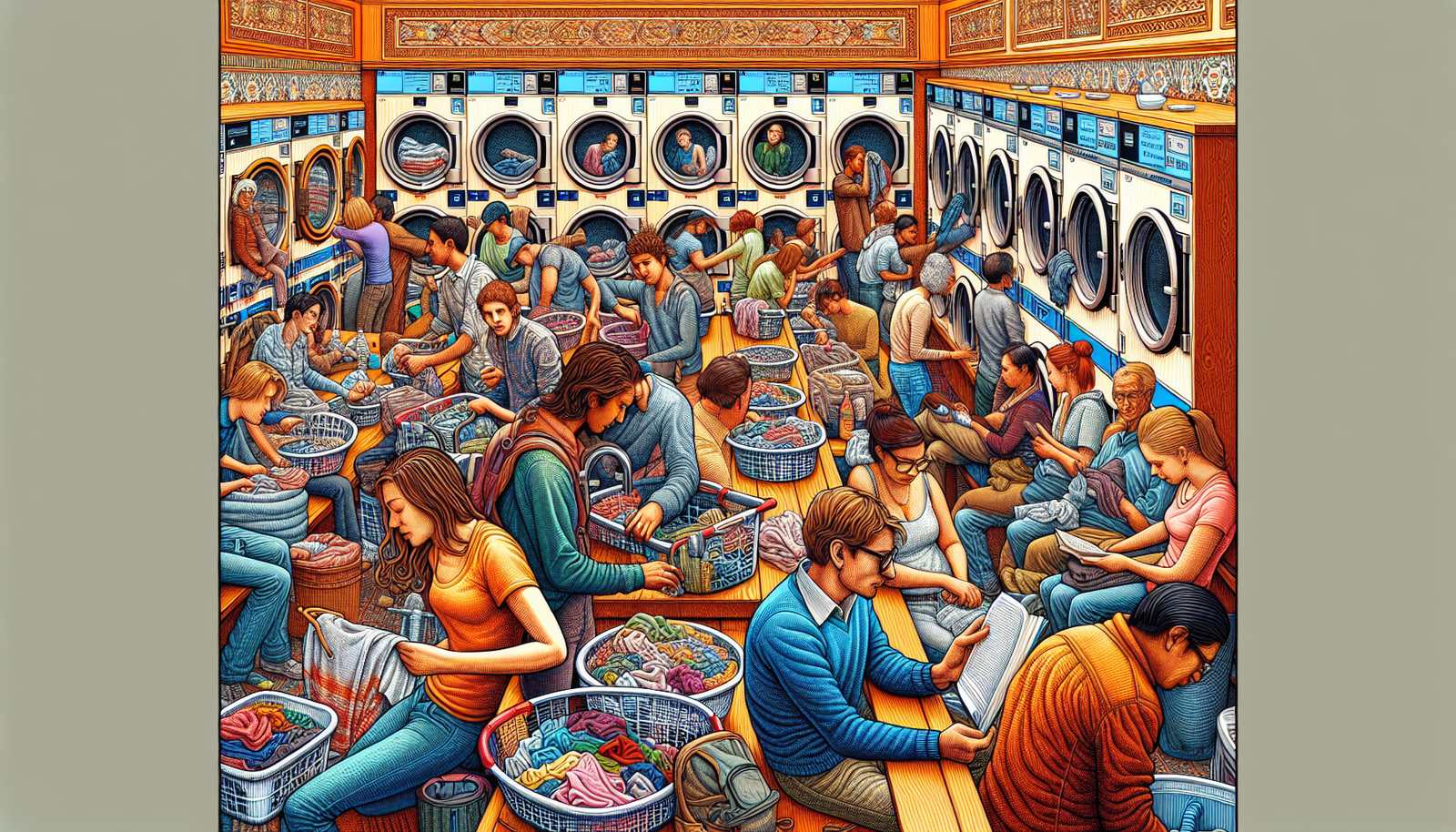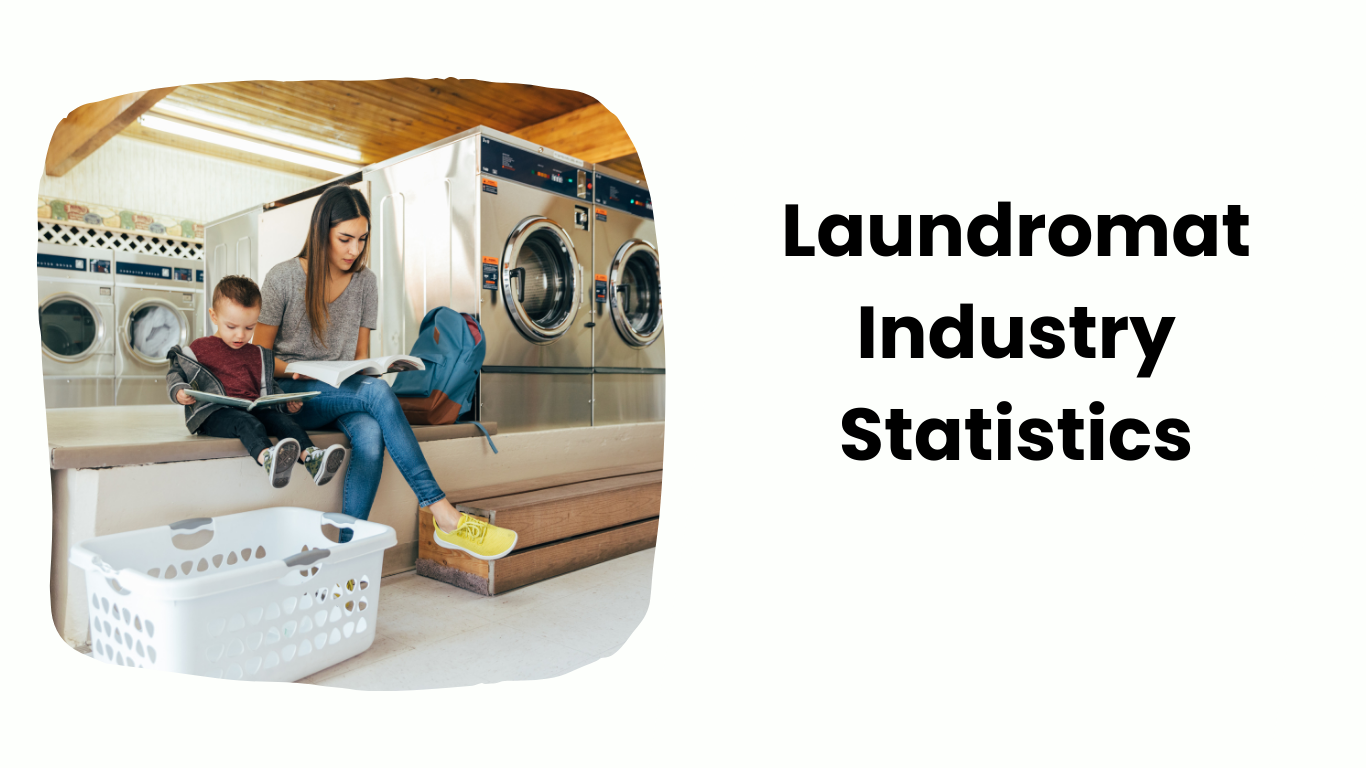With $5 billion in annual revenue and over 35,000 establishments, the laundromat industry is a significant player in the U.S. economy.
This article dives into crucial laundromat industry statistics, including key financial metrics, operational costs, customer demographics, and market growth opportunities.
Key Takeaways
The U.S. laundromat industry rakes in $5 billion annually, with over 35,000 establishments contributing to its robust presence.
Average laundromat revenue is about $142,000 annually, with net profit margins around 28%, making it a lucrative business opportunity.
Laundromats are increasingly adopting eco-friendly practices and advanced technologies like mobile payments and energy-efficient machines, catering to environmentally conscious customers.
Overview of the Laundromat Industry

Resilient through economic peaks and troughs, the laundromat industry has been a steadfast player in America’s commercial landscape for over a century. Today, it boasts a hefty $5 billion in annual revenue within the U.S., a testament to its significant role in the broader laundry services industry.
Thriving amidst socio-economic shifts, the laundromat business has seen a surge thanks to a growing working-class population and the relentless march of technological progress. With over 35,000 establishments dotting the nation, the laundromat landscape is as diverse as it is widespread, offering everything from the quintessential coin laundry experience to sophisticated, unattended operations.
It’s not just about providing washing machines; it’s about filling a vital need for many who lack the luxury of in-home laundry appliances.
Key Financial Statistics
Peek behind the ‘out of order’ signs and you’ll discover a robust financial backbone that keeps the average laundromat business wheels turning. With a global market size of a staggering $14.6 billion in 2020 and a forecasted annual growth rate of 1.7% through 2025, the laundromat business is a whirlwind of economic activity. In the U.S., the average laundromat churns out about $142,000 in annual revenue, contributing to an industry that’s all about the green—both in cash flow and eco-friendly practices.
And let’s not overlook the net profit margins, which average 28%, making laundromats a potentially lucrative venture for the savvy entrepreneur.
Annual Revenue Figures
When it comes to gross revenue, the laundromat industry in the U.S. contributes a clean $5 billion to the economy annually, a figure that’s anything but pocket change. Globally, the laundry market is on an upward trajectory, with projections estimating it will balloon to a substantial $39.34 billion by 2030, thanks to a compounded annual growth rate that’s got industry watchers spinning with excitement.
Average Monthly Revenue
The average laundromat spins out about $30,000 in monthly revenue—a figure that can surge upwards in the bustling streets of major cities or ebb in the quiet suburbs. Location, population density, and the bouquet of additional services offered can all influence this number, with some locations soaking up over $25,000 a month while others wring out a more modest $5,000.
Net Profit Margins
In the world of spin cycles and detergent, net profit margins average an impressive 28%, though they can vary based on a variety of factors. Laundromats offering a wider array of services, from wash-and-fold to dry cleaning, often find themselves pocketing higher profits, a trend that’s spinning up the industry’s overall appeal. Understanding the net cash flow of these businesses can be crucial for potential investors.
Operational Costs and Expenses
Running a laundromat isn’t all suds and smiles; it comes with a basket of operational costs and expenses. From the hum of the dryers to the churn of the washers, utility expenses can soak up between $2,000 to $6,000 monthly, accounting for a significant portion of a laundromat’s expenditures. Toss in rent or mortgage payments that can fluctuate wildly from $2,000 to a steep $10,000 per month, and you begin to understand the fiscal fabric of this industry.
All in all, the average laundromat in the U.S. faces around $19,889 in annual expenses, a number that underscores the importance of efficient operations.
Utility Costs Breakdown
Utility costs for laundromats can include:
Water
Electricity
Gas
Waste disposal
Savvy owners have learned that switching to energy-efficient machines or harnessing the power of solar panels can wring out substantial savings, both financially and environmentally.
Rent and Lease Expenses
The real estate market is much like a spin cycle—sometimes you’re up, sometimes you’re down—and laundromat lease costs are no exception, ranging anywhere from $2,000 to an eye-watering $10,000 per month. Some lease agreements may even include the bonus of maintenance and repair services, providing a little extra fabric softener for your monthly expenditure.
Maintenance and Repairs
The clink of coins isn’t the only sound in a laundromat; there’s also the occasional clank of a machine in need of TLC. Maintenance and repairs are an essential part of the laundromat life, with costs ranging from $500 to $2,000 monthly.
Regular maintenance not only keeps the machines running smoothly but also helps avoid costly breakdowns and the dreaded ‘out of order’ sign.
Customer Demographics and Behavior

Step into any laundromat and you’ll find a microcosm of society, with a customer base as varied as the colors of clothes they wash. Laundromats serve a cross-section of the community, including:
Renters
College students
Businesses
Travelers
Those facing economic constraints
With women making up nearly 60% of the clientele and nearly 40% of customers visiting weekly, it’s clear that laundromats are an integral thread in the fabric of daily life.
Typical Customer Profiles
The typical laundromat customer profile is as diverse as a mixed load of laundry. Economic currents have swayed more individuals towards rental living, especially those in the working class who rely on laundromats for their weekly wash. College students, often living in dorms or off-campus without their own washing machines, are also frequent patrons, adding to the vibrant tapestry of laundromat clientele.
Usage Frequency
The rhythmic opening and closing of laundromat doors mark the comings and goings of regulars who, depending on their pile of dirty laundry, may visit weekly or even more often. Larger households, especially, find themselves at the laundromat more frequently, spinning through loads of clothing with clockwork regularity.
Preferences and Trends
Laundromat customers today are not just looking for a place to wash their clothes; they’re seeking convenient services, quality, and eco-friendly options. Wash-and-fold services have become a staple, especially for time-starved professionals, and online laundry services are catching on thanks to their unmatched convenience.
Moreover, as environmental awareness grows, so does the appeal of laundromats that offer biodegradable products and reusable laundry bags, drawing in a customer base that values sustainability as much as cleanliness.
Market Segmentation and Growth Opportunities
As the laundromat business spins towards the future, opportunities for growth are popping up like lost socks behind the dryer. The market, ripe with potential, is segmented between residential and commercial clientele, each with its own set of needs and preferences.
Innovations in technology and evolving consumer behaviors also present exciting avenues for expansion, as laundromats look to diversify their offerings and tap into new segments in response to the rising demand.
Residential vs. Commercial Use
In the coin laundries landscape, the residential sector takes the lion’s share of the market, with working-class populations often relying on public laundromats for their cost-effective services. Meanwhile, the commercial segment sees businesses like hotels and restaurants utilizing laundromats for bulk cleaning, a trend driven by the market’s growing product diversity.
Technological Innovations

The coin laundry industry, also known as the laundromat industry, is not just spinning clothes; it’s spinning innovation. Mobile payments are beginning to replace the traditional coin slot, smart laundry machines are offering automation and energy efficiency, and technology is reshaping the very fabric of laundry services.
Expansion and Diversification
For the laundromat owner, growth often means spinning out into new locations or merging with non-competitive businesses to pool resources and expertise. By adopting strategies like loyalty programs or diversifying services, laundromats can weave a strong pattern of repeat business and customer loyalty.
Regional Market Insights
The laundromat business is not confined to one corner of the globe; it’s a worldwide whirlwind of activity. The industry’s fabric stretches across continents, with notable growth and unique market dynamics in each region.
North American Market
In North America, the laundromat market is robust, with a 45.1% market share in 2022 and a host of key players like American Dryer and Whirlpool Commercial keeping the industry in a steady spin. While the market has seen some fluctuations, the consistent demand for laundry services keeps the industry vibrant and competitive.
Asia Pacific Growth
The Asia Pacific region is witnessing a laundry revolution, with economic stability and rising living standards fueling a surge in demand for laundry services. Countries like China, Japan, and India are significant contributors to the region’s growth, with a projected CAGR that promises a robust future for the industry.
Environmental Impact and Sustainability
The environmental footprint of a laundromat can be as significant as the pile of clothes waiting for a wash. With industrial laundries consuming copious amounts of water, energy, and chemicals, the push for sustainability is becoming more than just a trend—it’s a necessity.
Adoption of Green Practices
Green is the new clean in the laundromat business. Eco-friendly practices, such as:
using biodegradable chemicals and detergents
installing energy-efficient machines
implementing water-saving measures
offering reusable laundry bags
are making waves as laundromats look to reduce their environmental impact and appeal to a growing eco-conscious customer base.
Water and Energy Efficiency
But it’s not just about the chemicals; it’s also about the resources. High-efficiency machines and water reuse systems are at the forefront of the sustainability charge, offering laundromat owners a way to not only lower their utility costs but also their environmental toll.
Innovations like low-flow faucets further contribute to this green movement, proving that every drop saved helps both the planet and the profit margins.
Recent Developments and Innovations
The laundromat industry is in the midst of a renaissance, with new developments and innovations reshaping the traditional model. As the global laundry market continues its upward trend, with an anticipated compound annual growth rate of 10.32%, laundromats are spinning up to meet the challenge with a variety of fresh, tech-savvy services.
New Service Offerings
Laundromats are no longer just about the machines; they’re becoming full-service laundry hubs. With a variety of laundromat services ranging from the ever-popular wash-and-fold to pet bedding and sports gear cleaning, laundromats are expanding their offerings to meet the diverse needs of their customers. Pickup and delivery services, in particular, are gaining traction, providing customers with the ultimate convenience and laundromat owners with new revenue streams.
Technological Advancements
The coins clinking in the slots are giving way to silent, cashless transactions as technological advancements usher in a new era for coin operated laundries. Smart laundry machines, remote management systems, and advanced point-of-sale systems are making the laundromat experience more convenient and efficient than ever.
These innovations not only enhance customer satisfaction but also streamline operations, allowing owners to manage their businesses with the touch of a button.
Summary
From their humble beginnings to the modern-day marvels of efficiency and convenience, laundromats have evolved into a vital part of our urban fabric. With robust financial figures, opportunities for growth through technological innovations and sustainable practices, and a diverse and loyal customer base, laundromats continue to offer an attractive investment opportunity and an essential service to communities worldwide. As we fold up this exploration of the laundromat industry, remember that behind every load of laundry, there’s a story of economic resilience and innovation.
Frequently Asked Questions
How much revenue does the average laundromat make annually?
The average laundromat makes about $142,000 in revenue annually in the U.S., contributing to the industry’s economic significance.
What are the average operational costs for a laundromat?
The average operational costs for a laundromat can range from $1,500 to $5,000 per month, with annual expenses averaging around $19,889.
Are laundromats considered a good investment?
Yes, laundromats can be a good investment with an average ROI of 20-35% over a 5-6 year period.
What technological innovations are impacting the laundromat industry?
Mobile payments, smart laundry machines, energy-efficient equipment, and advanced point-of-sale systems are revolutionizing the laundromat industry, making it more convenient and efficient for both customers and owners. These innovations are having a significant impact on the industry.
What environmental practices are laundromats adopting?
Laundromats are adopting environmentally friendly practices such as using high-efficiency machines, water reuse systems, biodegradable chemicals, eco-friendly detergents, and low-flow faucets to reduce water and energy consumption. This helps in conserving resources and minimizing environmental impact.

